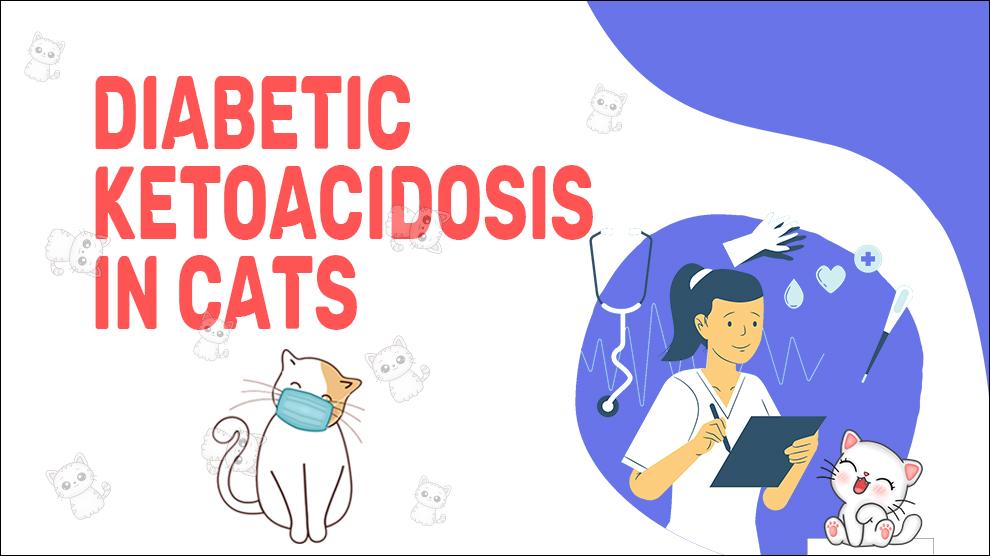What Is Diabetic Ketoacidosis In Cats?
DKA is a serious complication of uncontrolled diabetes mellitus that can quickly become life-threatening.
Common symptoms include vomiting, dehydration, loss of appetite, lethargy, and rapid breathing. Causes of DKA in cats include uncontrolled diabetes, stress, infections, and pancreatitis.
Treatment typically involves hospitalization, intravenous fluids, insulin therapy, electrolyte replacement, and monitoring of blood glucose and ketone levels.
Prevention of DKA involves proper management of diabetes through diet, exercise, and regular insulin injections.
Clinical Signs Of Diabetic Ketoacidosis In Cats
The symptoms of diabetic ketoacidosis can come on quickly and progress rapidly, so it's essential to seek veterinary care immediately if you notice any of the following signs:
- Vomiting or diarrhea
- Increased thirst and urination
- Loss of appetite and weight loss
- Lethargy or weakness
- Rapid breathing or panting
- Dehydration
- Sweet-smelling breath
- Disorientation or confusion
- Seizures or collapse
- Nausea
- Vomiting
- Depression
- Weight Loss
- Loss Of Muscle Mass
- Collapse
- Dark Yellow Color Urine
- Yellow Eyes
- Yellow Skin
- Yellow Gums
- Dull Coat
- Dandruff On Skin
- Not Eating
Treatment Options For Diabetic Ketoacidosis In Cats
Treatment for diabetic ketoacidosis typically involves hospitalization and intensive care.
The goals of treatment are to correct dehydration, restore electrolyte balance, lower blood glucose and ketone levels, and stabilize the cat's overall condition.
Treatment options may include:
- Intravenous fluids to correct dehydration and restore electrolyte balance
- Insulin therapy to lower blood glucose levels and prevent further ketone production
- Administration of bicarbonate to correct metabolic acidosis
- Monitoring of blood glucose and ketone levels to ensure they are within safe ranges
- Antibiotics to treat any underlying infections
- Supportive care, such as oxygen therapy, if the cat is experiencing respiratory distress
Home Remedies For Diabetic Ketoacidosis In Cats
Diabetic ketoacidosis is a medical emergency and requires immediate veterinary attention.
There are no home remedies for this condition, and attempting to treat it at home can be life-threatening.
How To Prevent Diabetic Ketoacidosis In Cats?
Preventing diabetic ketoacidosis in cats involves proper management of diabetes mellitus.
This includes:
- Maintaining a consistent feeding schedule and diet
- Administering insulin injections at the same time every day
- Monitoring blood glucose levels regularly and adjusting insulin doses as needed
- Providing adequate exercise and playtime
- Minimizing stress and anxiety in the cat's environment
- Regular veterinary check-ups to monitor blood glucose levels and overall health
Affected Cat Breeds Of Diabetic Ketoacidosis
Causes For Diabetic Ketoacidosis In Cats
Causes:
DKA occurs when there is a severe lack of insulin in the body, which can happen for a variety of reasons.
In cats, the most common cause of DKA is uncontrolled diabetes mellitus.
When a cat has diabetes, their body is unable to produce or effectively use insulin, which results in high levels of glucose in the bloodstream.
Over time, this can lead to a breakdown of fat for energy, which produces ketones.
Other possible causes of DKA in cats include:
- Stress or anxiety
- Infections or illnesses
- Pancreatitis
- Use of corticosteroids
- Surgery or trauma
When To See A Vet For Diabetic Ketoacidosis In Cats?
If you suspect that your cat is experiencing symptoms of diabetic ketoacidosis, it's essential to seek veterinary care immediately.
This is a life-threatening condition that requires prompt treatment to prevent serious complications or even death.
Your veterinarian will be able to perform diagnostic tests to confirm the diagnosis of DKA and develop a treatment plan to stabilize your cat's condition.
Food Suggestions For Diabetic Ketoacidosis In Cats
Proper nutrition is important for managing diabetes in cats and reducing the risk of diabetic ketoacidosis.
A high-quality, low-carbohydrate diet can help control blood sugar levels and prevent insulin resistance.
It is important to work with a veterinarian to determine the appropriate diet for your cat.
Conclusion
Diabetic ketoacidosis is a serious complication of diabetes in cats that can be life-threatening.
It is important for cat owners to be aware of the symptoms of diabetic ketoacidosis and to seek veterinary attention immediately if they suspect their cat may be affected.
With proper management of diabetes, including regular monitoring of blood sugar levels and appropriate insulin therapy, the risk of diabetic ketoacidosis can be minimized.











